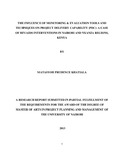| dc.description.abstract | This research project sought to determine the influence of Monitoring and Evaluation tools and techniques on Project Delivery Capability (PDC), in HIV/AIDS interventions in Nairobi and Nyanza regions in Kenya. The main objectives of the study were to determine how the use of Earned Value Management, Variance Analysis, Performance Reviews and Project Management Software influence Project Delivery Capability (PDC). The study reviewed literature related to the study problem, and specifically the influence of Monitoring and Evaluation tools and techniques on previous projects elsewhere in the world. The study adopted the cross sectional survey design. The survey method was considered most appropriate because the respondents in this study were uniquely qualified to provide the desired information. The study used primary and secondary methods of data collection. Primary data was collected through questionnaires which targeted Monitoring and Evaluation departments and specialists in organizations that offered HIV/AIDS intervention programmes in the two regions with the highest HIV/AIDS prevalence rates. Mugenda and Mugenda (1999) suggest that in descriptive studies ten percent of the survey population is representative enough to generalize characteristics being observed. In this study therefore 25% percent of the population constituted the sample size of 40. The target population was 160. Data analysis was done using (SPSS) Statistical Package for Social Science. Qualitative data was analyzed by coding according to variables in the study. Quantitative data was then analyzed through the use of descriptive statistics and the results then presented in form of tables. The results of the study revealed that Earned Value Management, Variance Analysis, Performance Reviews and Project Management Software were prevalent in use among 51%, 49%, 65% and 45% of the interventions respectively. 80% of the respondents said that more extensive and better use of Earned Value Management would enhance Project Delivery Capability (PDC). 82% of the respondents said that Variance analysis positively influenced Project Delivery Capability (PDC), while 85% said the use of Performance Reviews would enhance Project Delivery Capability (PDC). Project Management Software was the least used tool and 70% of the respondents said that more extensive and better use of the tool would enhance Project Delivery Capability (PDC). There were also other M&E tools and techniques in use in the HIV/AIDS interventions. The respondents recorded the use of impact assessment questionnaires (18%), feedback from target groups (17%), sample effect indicators (5%), incident report forms (15%), evaluation assessments (12%), benchmark tests (10%), time analysis among others. The study recommended increased training and awareness on Monitoring and Evaluation processes and procedures, enforcing of the existing structures, documentation of lessons learned and the tailoring of Monitoring and Evaluation solutions to the local setting. In conclusion, the study suggested two areas for further study. First, a study on Monitoring & Evaluation tools and techniques in use on other types of projects outside the health sector, for example, manufacturing, and secondly, a study on other tools and techniques used in the other parts of the Project Life Cycle in HIV/AIDS interventions in Kenya. | en |

